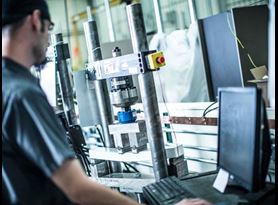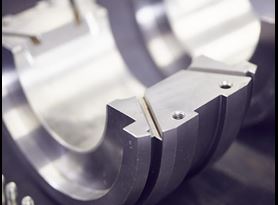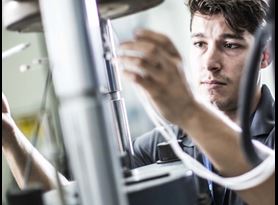Creep testing is critical to understanding and preventing product failures. Element performs both stress rupture and creep testing for metals, composites, and plastics to determine the long-term stress on materials.
Stress rupture and creep testing are specialized mechanical testing methods that provide manufacturers with critical data about their product's performance over time. During testing, a material is held under a definite constant temperature for a given period of time, at up to 1200°C (2192 °F), until failure occurs. Our experts then analyze the results to provide essential data about physical and thermal stress over extended periods.
How is a creep testing performed?
Creep testing is performed using a tensile specimen with a special design extensometer, applied constant stress, and temperature. The test is performed in furnaces or environmental chambers and recorded on a graph of strain versus time to show the creep rate
At a certain temperature and stress, materials begin to "creep," meaning they permanently deform. This can be observed in metals and alloys, ceramics, plastics, and even wood and stone. In metals, this process begins at about one-third of the melting temperature and increases at higher temperatures. Creep is caused by diffusion processes and dislocation movements in the material.
Creep is the time-dependent deformation of a material while under an applied load below its yield strength. It is most common at elevated temperatures, but some materials will exhibit creep at room temperature. Unless stopped, testing terminates in creep rupture.
What are the three stages of creep?
Creep occurs in three stages:
- Primary creep (stage I) – Start of the test. The creep curve is rising, and the creep rate is high at the start of the test, slowly decreasing with time.
- Secondary creep (stage II) – This is the stable part of the curve, where the creep rate is low and stable.
- Tertiary creep (stage III) – This is the final creep stage, the creep rate is rising at the same rate as elongation, and there is a reduction of the sample area. This will soon result in a rupture of the specimen.
What is stress rupture?
Stress rupture is the sudden and complete failure of a material under stress. During testing, the sample is held at a specific load level and temperature for a pre-determined amount of time. In stress rupture testing, loads may be applied by tensile bending, flexural, biaxial, or hydrostatic methods.
Our stress rupture and creep test services
With accreditations including ISO and Nadcap, Element is committed to providing the highest quality stress rupture and creep testing services to clients across many sectors. Our stress rupture testing and creep testing laboratories are continuously growing to meet the needs created by new and advanced materials.
The Element advantage
Element laboratories are also fully supported by experienced in-house machine shops that provide precise specimen preparation and fixture fabrication on all specimen and material types.
For more information about our stress rupture and creep test methods or to request a quote, contact an expert today.
What is Mechanical Testing and why is it Important throughout the Product Lifecycle?
Find out about what mechanical testing is and how it plays a key role in ensuring a cost-effective design as well as technological evolution and superiority.
Read MOREMaterials Testing: Choosing the Right Material for your Application
Materials testing provides valuable insight into the material characteristics such as hardness, flexibility, strength, and chemical composition, which provides a better understanding of the behavior of a material when subjected to operating conditions, explore our case study.
Read MOREWhat is Destructive Testing?
Destructive testing, also known as mechanical testing, subjects a material to different loads and stresses to evaluate its strength and durability. Read the article to learn about the different methods used for destructive testing.
READ MORERelated Services

Understanding your creep and stress rupture testing
How are creep and stress rupture tests performed? What results do stress rupture tests produce? Learn these answers and more from our article.

Fatigue Testing
Find out how Element's fatigue testing labs help companies meet quality requirements and create safer, stronger, more successful parts and products.

Metallurgical Testing
Find out more about our metallurgical testing expertise and our comprehensive range services, from grain size analysis to fractography.

Mechanical & Destructive Testing
Element's mechanical tests are part of our destructive testing services, they show whether a material or part is suitable for its intended mechanical applications.

